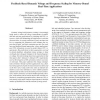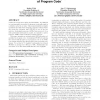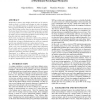73 search results - page 5 / 15 » Using Trace Scratchpads to Reduce Execution Times in Predict... |
DSN
2005
IEEE
14 years 1 months ago
2005
IEEE
This paper describes a framework for achieving node-level fault tolerance (NLFT) in distributed realtime systems. The objective of NLFT is to mask errors at the node level in orde...
RTAS
2005
IEEE
14 years 1 months ago
2005
IEEE
Dynamic voltage and frequency scaling is increasingly being used to reduce the energy requirements of embedded and real-time applications by exploiting idle CPU resources, while s...
DAC
2009
ACM
14 years 8 months ago
2009
ACM
Caches are notorious for their unpredictability. It is difficult or even impossible to predict if a memory access will result in a definite cache hit or miss. This unpredictabilit...
ICCS
2003
Springer
14 years 20 days ago
2003
Springer
Memory traces record the addresses touched by a program during its execution, enabling many useful investigations for understanding and predicting program performance. But complete...
DATE
2007
IEEE
14 years 1 months ago
2007
IEEE
Partitioning a memory into multiple blocks that can be independently accessed is a widely used technique to reduce its dynamic power. For embedded systems, its benefits can be ev...



